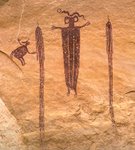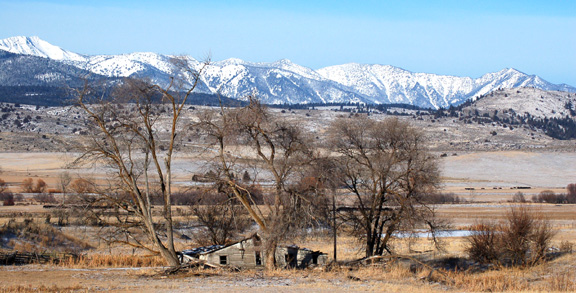[Edited and updated 8/23/13]
This blog may contain more information about Cryptosporidium than some people want. If so, skip down to the YouTube videos at the end. One from Wally Sykes in Wallowa County about a Wolverine, and the other about the activities of the Sheriff in Malheur County. As usual, if they don't play, click on the title above the video, and it will take you directly to the YouTube video. The
previous blog on this subject has also been updated.
__
One of the interesting problems associated with the 1993 Milwaukee, WI, Cryptosporidum outbreak, which affected some 400,000 people directly, was that the actual cause was never determined. Those that studied the epidemic could not come to a definitive conclusion as to whether it was caused by dairy cattle or a sewage issue.
Most of us would like to know the primary cause of disease outbreaks that create such damaging effects to people's health and financial well being, so that we can prevent them from happening in the future. This is certainly here in Baker City, where we face large expenditures necessitated by the state and federal drinking water rules, and where economic losses due to sickness and curtailment of business activity have been large. When the cause remains obscure, correcting such a problem efficiently becomes extremely difficult. If we knew for certain that the problem was caused by mountain goats, elk, cows, (and yes, I've heard "sabotage" offered up) or some other specific agent or event, we could zero in on effective solutions that might save us millions of dollars that would otherwise be directed at prevention associated with unknown causes and for unknown reasons.
As of now, given the available information, the cause of our Crypto outbreak remains a mystery.
I have tried this week to get information from the County Health Department and the Oregon Health Authority about what kinds of tests have been performed on what types of samples in order to help people understand more about the actual cause of our waterborne Cryptosporidium outbreak. Information is hard to come by, at least for me, although it appears that mountain goats are no longer a suspect. Yesterday morning, Alicia Hills from our County Public Health Department, was able to reveal that the tests on mountain goat scat were negative for Cryptosporidium. That, coupled with few crypto oocysts in Goodrich Reservoir, tends to count them out as a significant contributor to any crypto load in the watershed.
Here is the crux of my problem as a citizen blogger trying to get current relevant information: On July 16, 2013, I asked the Oregon Health authority (OHA) for information about a different potential health problem. As of today, they have not answered my questions.
Yesterday I left a message to an OHA person concerning our crypto outbreak, and what kinds of tests have been performed on what types of samples, because the intermediate contact allowed me to leave them a message. I had asked them the same questions on Tuesday. I have not received a return call. I was not able to talk to a person even remotely connected to the Crypto outbreak study until today, and he promised to try to find answers to the questions I asked from some unknown person who is supposed to have some idea about what is going on. Additionally, the state drinking authority contact that used to respond to my questions has gone silent [Seems to be back today! 8/23/13]. Apparently, I'm not a preferred provider of information to the public. If history is a guide. . . .
The city though, has in some cases been responsive (I'm grateful), but trying to get information on the
current costs of UV treatment vs filtration remains frustrating, even though people are forming opinions on the choice we should make without adequate information about the current costs to be borne in the long term. Once people commit to an opinion, positions tend to harden, and some will try to defend their opinion regardless of new information. That is why Herald editorials and Herald opinion polls in the middle of a crisis, before adequate information is provided, do not serve the public well. It can though be an effective strategy for advancing a position without regard to the financial welfare of the community.
For review, here are the figures for treatment options from November 22, 2009 (Capital is essentially the cost of the plant, "$M" stands for MILLIONS of dollars, O and M stands for yearly Operation and Maintenance [multiply by $1,000 so 332 means $332,000 yearly O and M costs]):
Table 2. Cost Opinion for LT2ESWTR Compliance Options
Compliance Option Capital ($M) O and M ($1,000/yr) Present Worth ($M)
UV 2.3 13 2.5
Ozone 4.8 89 5.8
Chlorine Dioxide 12.7 74 13.6
Membrane Filtration 17.7 332 21.5
Notes:
1. Capital Cost includes Engineering and Services During Construction
2. Oxone and Chlorine Dioxide costs from Formation and Control of DBPs in Drinking
Water, AWWA 1999. Chlorine Dioxide costs include 12-MG contact tank.
3. UV Costs from UV Disinfection Costs for Inactivating Cryptosporidium, JAWWA June
2001
4. Costs updated to June 2009 dollars using ENR 20-city average construction cost index
Assumptions:
Average Annual Flow = 4 mgd
Plant Capacity = 12 mgd
Discount (interest) rate = 6%
Amortization Period = 20 yrs
Engineering and Services During Construction = 25%
Contingency on Capital Costs = 30%
The information available from 2009, as well as the information provided below, would indicate that committing to filtration at this point is ill advised.
Getting back to the cryptic aspects of the crypto outbreak: what kinds of tests have been performed on what types of fecal material and water samples, so that we can understand more about the actual cause of our waterborne Cryptosporidium outbreak? Alicia Hills said that the only test result she had was the negative test for Cryptosporidium in mountain goat scat, and that she did not know what all the samples taken consisted of. She did not know whether the cattle fecal material found near the Elk Creek water supply intake had been tested. After all, no one was aware, or at least admitting, that cattle had been in the watershed until after I asked first Mike Kee, and then Clair Button, to go with me to investigate on August 12--a request that resulted in our August 19th trip to Elk Creek. Given the washed out condition of some of the more recent cattle fecal material found on that date, it is conceivable that some of it was present prior to the August 1 rain event. No one I've talked to thus far has been able to answer the question of whether they have tested the more recent fecal material from cattle in the watershed, and those who should know have not returned my calls.
Without that information, it all remains a mystery.
So I get to poke around the edges in the dark because the state is not responsive. I hate to resort to public records requests, but may have to.
Two Cow Pies up on trail to the east of the water supply diversion at Elk Creek. They look older than a week, but less than two months old. If modern science can radiocarbon date a dinosaur bone that is millions of years old, one might expect that they can date a cow pie of recent origin? Maybe it isn't sensitive enough for that.
One can though, do research on the published scientific findings from studies published on the internet. Reading through the findings may be challenging for some, but I encourage everyone to do so. It is not entertainment unless you have a fondness for facts, but it can be enlightening. Here are some of those findings (Direct quotations are in italics with underlining added, all misunderstandings obviously my own):
1)
From Genotyping Cryptosporidium from water to source track fecal contaminationin agricultural watersheds from a Thesis by Norma Jean Ruecker, UNIVERSITY OF CALGARY, JANUARY, 2013. (I rely on this first because it is recent and incorporates information from many previous studies.)
Species originating from wildlife represented a low risk to human health.
Molecular tools exist for effective molecular characterization of Cryptosporidium oocysts in water so as to identify host sources and individual species or genotypes (paraphrased). It is ... important that the molecular tools used for characterizing human isolates are capable of detecting all known species/genotypes of Cryptosporidium. In other words, the ability exists to make decisions about the probable cause of a crypto outbreak, and to differentiate between pathogenic and non pathogenic species and genotypes of Cryptosporidium in your water supply and in fecal samples tested.
Ultimately, these approaches can be used to characterize sources of fecal pollution in the environment and aid in the development of mitigation strategies focused on reducing the burden of Cryptosporidium in drinking water sources in an effort to protect public health.
A thorough review of the published surveys of Cryptosporidium in cattle reported prevalence ranges from 0 to 100% with typically higher rates in younger animals compared to older ones.
With C. parvum being the only cattle-associated species which has been demonstrated to be a significant zoonotic risk to humans [a human pathogen--cause of disease in humans], the knowledge of age dependent prevalence challenges the current understanding of the risk that cattle associated Cryptosporidium spp. pose to public health.
As C. parvum has been detected in all the major livestock species, it poses the greatest risk for zoonotic transmission to humans. Pre-weaned calves are considered the major animal host for C. parvum and the most likely source of zoonotic cryptosporidiosis. [Although Cryptosporidium parvum does exist in weaned calves. Chris]
recently as many as 25 species and close to 50 genotypes [of Cryptosporidium] have been described. This information provides a solid framework for assessing public health risks and also allows tracking of the host sources associated with Cryptosporidium contamination in the
environment.
The species of high risk to human health were present in only 1.2% of the samples analyzed. This knowledge challenges the LT2ESWTR regulation in the US by providing evidence that the regulation may be overprotective, leading, in some cases, to unnecessary capital expenditures for water utilities. Of the 25 species and ~50 genotypes of Cryptosporidium described, only 2 species, C. hominis and C. parvum, account for 95% of human clinical infections. Only a few other Cryptosporidium species and genotypes account for all other clinical infections in humans. This study demonstrates that although 45% of all the water samples analyzed had Cryptosporidium oocysts detected, only 17% of the samples had species or genotypes detected which have been associated with human infections. Species of Cryptosporidium that are considered to be of high risk to humans: C. hominis and C. parvum. Two others are medium risk and three are low risk. The rest are considered no risk.
sustained viability [of crypto oocysts] is dependent upon the environmental conditions they are exposed to (i.e., solar UV inactivation, dessication, fermentation). [I would add freezing--see later citation]
It is a conclusion of this thesis that until improved and more accurate models can be developed, Cryptosporidium monitoring including genotyping is the only reliable way to assess parasite loading in surface water.
Hazard identification is considered the central element, or foundational basis, of the risk assessment framework from which the other components are derived. . . . .Simply put, not all Cryptosporidium parasites observed in water are infectious to humans. Even when considering those that are hazardous to humans, a relative level of risk exists (i.e., high, medium, low).
detection and subsequent molecular characterization of Cryptosporidium oocysts in water can be used to infer potential host sources of fecal pollution impacting water quality within a watershed, an extremely important part of the risk mitigation element of the risk assessment framework. Identifying the sources of pollution contributing to the Cryptosporidium burden allows for the development of watershed protection strategies designed to reduce or mitigate these environmental burdens.
data presented in this thesis suggests that wildlife appear to represent little risk to public health in the development of cryptosporidiosis in humans. In this context, management of wildlife may not be necessary or worthwhile in terms of risk mitigation for some drinking water systems.
the Water Research Foundation (financially supported by water utility subscribers) initiated a request for proposals entitled: “Selecting and Standardizing the Most Appropriate Cryptosporidium Genotyping Tool for Regulatory Compliance Monitoring”, in 2009, with the intent of developing a validated Cryptosporidium genotyping tool suitable for inclusion into the regulatory water quality monitoring frameworks of the USEPA (LT2ESWTR)
- Regulators of the water industry are likely to remain risk adverse and therefore moving forward, municipal water utilities will continue to challenge regulation through the use of applied science. This will be driven by the need for municipalities to balance fiscal responsibility with public health safety.
- Cryptosporidium oocysts were more environmentally resistant. At −4 and 4°C, the oocysts could survive in water and soil for 12 wk but degradation was accelerated at 25°C. Cryptosporidium oocysts also were degraded more rapidly in feces and in soil containing natural microorganisms. [Crypto oocysts survive for over three months in water at 24.8 and 39.2 degrees fahrenheit, as might be expected in frozen and unfrozen water, and under a blanket of snow. Most microorganisms are not going to be very active at 24.8 degrees and so will not be degrading crypto oocysts.]
3)
Effects of Low Temperatures on Viability of Cryptosporidium parvum Oocysts
All mice that received oocysts frozen at -10 [degrees] C [14 degrees fahrenheit] for 8, 24, and 168 h and those that received oocysts stored at 5 [degrees] C for 168 h had developmental-stage parasites. These findings demonstrate for the first time that oocysts of C. parvum in water can retain viability and infectivity after freezing and that oocysts survive longer at higher freezing temperatures. [This implies that oocysts may survive at 14 degrees F for some time]
- In nature, survival of oocysts might be extended beyond the times observed in the present study when water containing minerals or organic material is frozen or when oocysts are frozen at temperatures above -10 [degrees]C [14 degrees fahrenheit]. Such conditions might be found in areas where, after ground temperatures fall to just below freezing, a layer of snow insulates that surface from much colder air temperatures, enabling oocysts to survive perhaps for weeks or months.
Cryptosporidium oocysts:
- Can remain viable for greater than 6 months at 20 degrees Celsius in water (Fayer and others, 2000.
- In three environmental freshwaters, 0.1% survival over 10 weeks at 25 degrees and higher rates of survival at 4 degrees (Simmons and Sobsey, 2002).
- Survival and infectivity in freshwater detected after more than 12 weeks (Olson and others 1999).
5)
Surface Water Quality--Overland and Near-Surface Transport of Cryptosporidium parvum from Vegetated and Nonvegetated Surfaces
Livestock, both open range and those in concentrated animal facilities, have been associated with high concentrations of C. parvum. . . . . Infected animals can pass as many as 10 billion oocysts per gram of feces, and a small number of infected animals can produce enough oocysts to potentially contaminate a large water source. [This goes a long way toward explaining how a small amount of infected fecal material from an infected calf in a water supply could contaminate the water around, say, a water supply intake in a small creek.]
6)
Cryptosporidiosis of Livestock
- C. parvum, C. andersoni, C. canis, C. felis, C. hominis, and C. suis, have been reported in human infections. [The vast majority by C. parvum and C. hominis]
. . . in order to accurately assess the risk that livestock might pose to humans, molecular-based prevalence studies are necessary. Such studies could help to identify potential source of these organisms causing human infection, and lead to improved control strategies. Greater understanding of the species and genotypes present in animals and the patterns of transmission can improve our ability to control these infections will hopefully result in significant benefits to society in terms of both animal and human health.
7)
Concentrations of Pathogens and Indicators in Animal Feces in the Sydney Watershed
- Pathogen and fecal indicator concentrations were generally higher in domestic animal feces than in wildlife feces. Future studies to quantify potential pathogen risks in drinking-water watersheds should thus focus on quantifying pathogen loads from domestic animals and livestock rather than wildlife.
Lastly: On Cryptosporidium detection limits:
- . . . the detection limit of the analytical method, about 0.1 oocysts per liter; . . . .
_____
AP Article on Incident:
Flight recorders found in deadly UPS plane crash
Sheriff says FBI to probe activist traffic stop
Published: August 14, 2013
By JEFF BARNARD — Associated Press
GRANTS PASS, Ore. —
. . . .
"We are sending all information and recordings that we have (to the FBI) and they will look at it," Sheriff
Brian E. Wolfe told The Associated Press in an email.
"I want to make sure nothing was done wrong," he said.
. . . .
Wolfe acknowledged that two deputies, acting on orders from a supervisor, pulled over Steve Hindi, . . . .
Wolfe said there was no traffic violation or evidence of any other crime.
Deputy Brian Belnap and Deputy Brian Beck were on duty and following orders from their supervisor, Lt. Rob Hunsucker, Wolfe said. There was no probable cause a crime or traffic violation had been committed.
No one has been disciplined or placed on leave, he said.
. . . .


























